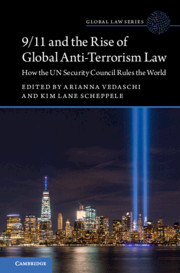Book contents
- 9/11 and the Rise of Global Anti-Terrorism Law
- Global Law Series
- 9/11 and the Rise of Global Anti-Terrorism Law
- Copyright page
- Contents
- Contributors
- Foreword
- Introduction
- Part I The Globalization of Anti-Terrorism Law: Theoretical Frameworks
- Part II Connecting the Global and the Local in Fighting Terrorism: Applications
- 6 Moving toward the Criminalization of “Pre-crime”
- 7 Secret Evidence in Civil Litigation against the Government
- 8 The Regulation of Intelligence Cooperation under International Law
- 9 Predictive Technologies and Opaque Epistemology in Counterterrorism Decision-Making
- 10 Removing Terrorist Content Online
- Conclusion
- Appendix: The UN Security Council and the Rule of Law: The Role of the Security Council in Strengthening a Rules-Based International System
- Index
7 - Secret Evidence in Civil Litigation against the Government
The Lasting Impact of UN Security Council Resolution 1373 on Procedural Fairness in Canada and the United Kingdom
from Part II - Connecting the Global and the Local in Fighting Terrorism: Applications
Published online by Cambridge University Press: 01 July 2021
- 9/11 and the Rise of Global Anti-Terrorism Law
- Global Law Series
- 9/11 and the Rise of Global Anti-Terrorism Law
- Copyright page
- Contents
- Contributors
- Foreword
- Introduction
- Part I The Globalization of Anti-Terrorism Law: Theoretical Frameworks
- Part II Connecting the Global and the Local in Fighting Terrorism: Applications
- 6 Moving toward the Criminalization of “Pre-crime”
- 7 Secret Evidence in Civil Litigation against the Government
- 8 The Regulation of Intelligence Cooperation under International Law
- 9 Predictive Technologies and Opaque Epistemology in Counterterrorism Decision-Making
- 10 Removing Terrorist Content Online
- Conclusion
- Appendix: The UN Security Council and the Rule of Law: The Role of the Security Council in Strengthening a Rules-Based International System
- Index
Summary
UN Security Council Resolution 1373 is rightly viewed as the most significant international instrument pertaining to countering terrorism. Two features of the resolution are of concern to us: the sharing of security intelligence and other information, and, restrictions to human mobility. These two dimensions of global counterterrorism dovetail within the dark underbelly of the securitization of migration. There have been several high-profile instances where the United Kingdom and Canada have been directly involved in deportation to torture. Victims have faced numerous obstacles securing remedies for human rights violations. Perhaps most significant is the unwillingness of states to disclose relevant information during civil litigation, owing to national security or more broadly public interest privilege.
The United Kingdom has approached this problem by instituting “Closed Material Proceedings” (CMPs), where courts may base decisions on secret evidence, with the benefit of security-cleared Special Advocates mandated to represent the interests of plaintiffs. Canadian authorities have considered similar measures, having a rich history of secret hearings. Clearly, the use of secret evidence raises serious rule of law issues, as well as many practical, professional, and ethical challenges. This chapter explores these issues in the context of civil litigation of state responsibility for torture and other human rights abuses. As part of an ongoing socio-legal study on CMP in Canada and the UK, this chapter presents documentary and empirical findings, including interviews with judges, Special Advocates, and court administrators in both jurisdictions.
Keywords
- Type
- Chapter
- Information
- 9/11 and the Rise of Global Anti-Terrorism LawHow the UN Security Council Rules the World, pp. 155 - 178Publisher: Cambridge University PressPrint publication year: 2021



